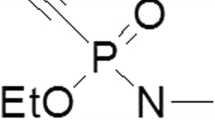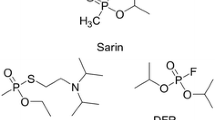Abstract
Methoxime (MMB-4) is a leading candidate oxime acetylcholinesterase (AChE) reactivator to replace pralidoxime (2-PAM) for therapeutic treatment of nerve agent intoxication. 4-Pyridine aldoxime (4-PA) is a synthetic starting material, a breakdown product, and a probable metabolite of MMB-4. There is a possibility that 4-PA may adversely interact with the nerve agent, thereby affecting nerve agent toxicity and biological AChE activity. This study evaluated the effects of 4-PA on sarin (GB)-, cyclosarin (GF)-, and VX-induced toxicity and AChE activity in blood, brain, and peripheral tissues of guinea pigs. Animals were pretreated with atropine methyl nitrate (1.0 mg/kg, im) 15 min prior to subcutaneous administration with 1.0× LD50 of GB, GF, or VX and then treated 15 min after the administration of nerve agents with 4-PA (3.5, 7.0, or 14.0 mg/kg, im). The dose–response effects of 4-PA alone were also examined. Toxic signs and lethality were monitored, blood and tissues were collected, and AChE activities were determined at 60 min after nerve agent administration. Under the condition of this study, all animals exposed to nerve agents exhibited some degree of toxic signs such as salivation, lacrimation, rhinorrhea, and convulsions. 4-PA at the three doses tested neither induced toxic signs nor altered the toxicity of GB, GF, or VX at the 1.0× LD50 exposure dose. Additionally, it did not modify the AChE activity in blood, brain, and peripheral tissues by itself or affect the AChE activity inhibited by a 1.0× LD50 dose of these three nerve agents in guinea pigs.




Similar content being viewed by others
Abbreviations
- ACh:
-
Acetylcholine
- AChE:
-
Acetylcholinesterase
- AMN:
-
Atropine methyl nitrate
- ChE:
-
Cholinesterase
- BCA:
-
Bicinchoninic acid
- DTNB:
-
5,5′-Dithiobis-2-nitrobenzoic acid
- GB:
-
Sarin
- GF:
-
Cyclosarin
- im:
-
Intramuscular
- LD50 :
-
Median lethal dose
- MMB-4:
-
Methoxime
- OP:
-
Organophosphorus compound
- 2-PAM:
-
Pralidoxime; pyridine-2-aldoxime methylchloride
- 4-PA:
-
4-Pyridine aldoxime
- PB:
-
Pyridostigmine bromide
- RBC:
-
Red blood cell
- sc:
-
Subcutaneous
- WB:
-
Whole blood
References
Aas P (2003) Future considerations for the medical management of nerve-agent intoxication. Prehosp Disaster Med 18:208–216
Ancill RJ (1956) The blood volume of the normal guinea pig. J Physiol 132:469–475
Boskovic B, Kovacervic V, Jovaniovic D (1984) PAM-2 Cl, HI-6, and HGG-12 in soman and tabun poisoning. Fundam Appl Toxicol 4:S106–S115
Childs AF, Davies DR, Green AL, Rutland JP (1955) The reactivation by oximes and hydroxamic acids of cholinesterase inhibited by organophosphorus compounds. Br J Pharmacol Chemother 10:462–465
Clair P, Wiberg K, Granelli I, Carlsson BI, Blanchet G (2000) Stability study of a new antidote drug combination (Atropine-HI-6-prodiazepam) for treatment of organophosphate poisoning. Euro J Pharmaceut Sci 9:259–263
Ellman GL, Courtney KD, Andres V Jr, Featherstone RM (1961) A new and rapid colorimetric determination of acetylcholinesterase activity. Biochem Pharmacol 7:88–95
Hobinger F, Sadler PW (1959) Protection against lethal organophosphate poisoning by quaternary pyridine aldoximes. Br J Pharmacol Chemother 14:192–201
Holmes R, Robins EL (1955) The reversal by oximes of neuromuscular block produced by anticholinesterases. Br J Pharmacol Chemother 10:490–495
Moore DH, Clifford CB, Crawford IT, Cole GM, Baggett JM (1995) Review of nerve agent inhibitors and reactivators of acetylcholinesterase. In: Quinn DM, Balasubramanian AS, Doctor BP, Taylor P (eds) Enzymes of the cholinesterase family. Plenum Press, New York, pp 297–304
Sakurada K, Ikegaya H, Ohta H, Akutsu T, Takatori T (2006) Hydrolysis of an acetylthiocholine by pralidoxime iodide (2-PAM). Toxicol Lett 166:255–260
Saxena A, Luo C, Chilukuri N, Maxwell DM, Doctor BP (2008) Novel approaches to medical protection against chemical warfare nerve agents. In: Romano JA, Lukey JA, Salem H (eds) Chemical warfare agents: chemistry, toxicology and therapeutics, 2nd edn. Pharmacology, CRC Press, Boca Raton, pp 145–173
Shih T-M, Kan RK, McDonough JH (2005) In vivo cholinesterase inhibitory specificity of organophosphorus nerve agents. Chem Biol Interact 157–158:293–303
Singh H, Moorad-Doctor D, Ratcliffe RH, Wachtel K, Castillo A, Garcia GE (2007) A rapid cation-exchange HPLC method for detection and quantification of pyridinium oximes in plasma and tissue. J Analy Toxicol 31:69–74
Taylor P (2001) Anticholinesterase agents. In: Hardman JG, Limbird LE, Gilman AG (eds) Goodman and Gilman’s the pharmacological basis of therapeutics, 10th edn. McGraw-Hill, New York, pp 175–191
Vallejo-Freire AA (1951) A simple technique for repeated collection of blood samples from guinea pigs. Science 114:524–525
Wilson IB, Ginsburg S (1955) Reactivation of acetylcholinesterase inhibited by alkylphosphonates. Arch Biochem Biophys 54:569–571
Acknowledgments
Excellent technical team work of John Guarisco, John O’Donnell, Anna Smelley, Kerry van Shura, Cindy Acon-Chen, Shelby Brooks, Jessica Chandler, Teresa Ferrara, Jeff Koenig, Megan Lyman, and Kristin Tarzia is acknowledged. This research was supported by the Medical Identification and Treatment Systems Joint Product Management Office, U.S. Army Medical Research and Materiel Command.
Author information
Authors and Affiliations
Corresponding author
Additional information
Research was conducted in compliance with the Animal Welfare Act and other Federal statutes and regulations relating to animals and experiments involving animals and adhered to principles stated in the Guide for the Care and Use of Laboratory Animals, by the Institute of Laboratory Animal Resources, National Research Council. The research environment and protocols for animal experimentation were approved by the Institutional Animal Care and Use Committee (IACUC) of the US Army Medical Research Institute of Chemical Defense. The facility where this research was conducted is fully accredited by the Association for Assessment and Accreditation of Laboratory Animal Care International (AAALAC). The opinions or assertions contained herein are the private views of the authors and are not to be construed as reflecting the views of the Department of the Army or the Department of Defense.
Rights and permissions
About this article
Cite this article
Shih, TM., Skovira, J.W. & McDonough, J.H. Effects of 4-pyridine aldoxime on nerve agent-inhibited acetylcholinesterase activity in guinea pigs. Arch Toxicol 83, 1083–1089 (2009). https://doi.org/10.1007/s00204-009-0465-4
Received:
Accepted:
Published:
Issue Date:
DOI: https://doi.org/10.1007/s00204-009-0465-4




